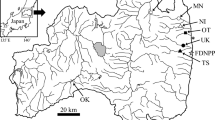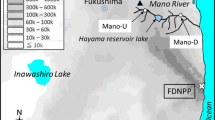Abstract
The Fukushima nuclear accident led to deposition of radionuclides into the freshwater fishery ground of ayu Plecoglossus altivelis. For the purpose of more comprehensive understanding of the radioactive contamination, cesium-137 (137Cs) was analyzed in running water, muddy sediment, attached algae, and ayu using samples from three river systems with different levels of contamination within Fukushima Prefecture in summer and autumn 2011. The amount of 137Cs contained in water as well as in sediment declined over an interval of two months, although the concentration in sediment samples was up to 10,000-fold higher than that in water samples. The changes in 137Cs concentration of algae showed different courses among the three river systems, the concentration being greater in autumn in the river systems with high and moderate radioactive contamination. 137Cs detected within a single stock of ayu appeared to be excreted rather rapidly with a calculated half-life of approximately 39 days, while the concentration ratio ranged from 103 to 104 l/kg, attaining higher levels than previously reported. These findings indicate that the most important pathway of 137Cs into ayu is via intake of algae as food but that the retention time of 137Cs inside ayu is relatively short.





Similar content being viewed by others
References
Garnier-Laplace J, Beaugelin-Seiller K, Hinton TG (2011) Fukushima wildlife dose reconstruction signals ecological consequences. Environ Sci Technol 45:5077–5078
Chino M, Nakayama H, Nagai H, Terada H, Katata G, Yamazawa H (2011) Preliminary estimation of release amounts of 131I and 137Cs accidentally discharged from the Fukushima Daiichi nuclear power plant into the atmosphere. J Nucl Sci Technol 48:1129–1134
Yasunari T, Stohl A, Hayano RS, Burkhart JF, Eckhardt S, Yasunari T (2011) Cesium-137 deposition and contamination of Japanese soils due to the Fukushima nuclear accident. Proc Natl Acad Sci USA 108:19530–19534
Buesseler KO, Jayne SR, Fisher NS, Rypina II, Baumann H, Baumann Z, Breier CF, Douglass EM, George J, Macdonald AM, Miyamoto H, Nishikawa J, Pike SM, Yoshida S (2012) Fukushima-derived radionuclides in the ocean and biota off Japan. Proc Natl Acad Sci USA 109:5984–5988
Hamada N, Ogino H (2011) Food safety regulations: what we learned from the Fukushima nuclear accident. J Environ Radioactiv in press
Iguchi K, Tanimura Y, Takeshima H, Nishida M (1999) Genetic variation and geographic population structure of amphidromous ayu Plecoglossus altivelis as examined by mitochondrial DNA sequencing. Fish Sci 65:63–67
Iguchi K, Hino T (1996) Effect of competitor abundance on feeding territoriality in a grazing fish, the ayu Plecoglossus altivelis. Ecol Res 11:165–173
Yamamoto H (2000) Changes in the performance of ayu angling tracked from a personal diary. Rep Yahagi River Inst 4:169–175 (in Japanese with English summary)
Kubota H, Tezuka K, Fukutomi N (2008) Discrimination of stock origins of ayu Plecoglossus altivelis caught by angling, using microsatellite DNA markers and evaluation of stocking effectiveness. Nippon Suisan Gakkaishi 74:1052–1059 (in Japanese with English summary)
Abe S, Tamaki Y, Iguchi K (2011) Valuation of ecosystem services in restocking with ayu (Plecoglossus altivelis) in Japan. In: Stickney R et al (eds) proceedings of the Thirty-eighth U.S.–Japan Aquaculture Panel Symposium, NOAA Technical Memorandum NMFS-F/SPO-113, Washington, pp. 47–51
Munakata A, Settai N (2010) Preservation activity that promote the seightseen with an aim to conserve the natural resources of Hirose River in Sendai City. Bull Miyagi Univ Edu 45:91–97 (in Japanese)
Leggett RW, Williams LR, Melo DR, Lipsztein JL (2003) A physiologically based biokinetic model for cesium in the human. Sci Total Envion 317:235–255
Christodouleas JP, Forrest RD, Ainsley CG, Tochner Z, Hahn SM, Glatstein E (2011) Short-term and long-term health risks of nuclear-power-plant accidents. N Engl J Med 364:2334–2341
Unterweger MP, Hoppes DD, Schima FJ (1992) New and revised half-life measurements results. Nucl Instrum Methods Phys Res, Sect A 312:349–352
Hosono K (2011) Coping with the aftermath of the Fukushima Daiichi nuclear disaster from the side of data, information, and knowledge. J Jpn Soc Inform Knowl 22:3–8
Reardon S (2011) Fukushima radiation creates unique test of marine life’s hardiness. Science 332:292
Smith JT, Kudelsky AV, Ryabov IN, Daire SE, Boyer L, Blust RJ, Fernandez JA, Hadderingh RH, Voitsekhovitch OV (2002) Uptake and elimination of radiocaesium in fish and the “size effect”. J Environ Radioactiv 62:145–164
Tsumura A, Komamura M, Kobayashi H (1984) Behavior of radioactive Sr and Cs in soils and soil-plant systems. Bull Natl Inst Agro-Environ Sci Ser B 36:57–133 (in Japanese with English summary)
Yamaguchi N, Takata Y, Hayashi K, Ishikawa S, Kuramata M, Eguchi S, Yoshikawa S, Sakaguchi A, Asada K, Wagai R, Makino T, Akahane I, Hiradate S (2012) Behavior of radiocaesium in soil-plant systems and its controlling factor: a review. Bull Natl Inst Agro-Environ Sci 31:75–129 (in Japanese with English summary)
Suzuki Y, Nakamura R, Ueda T (1973) Cesium-137 contamination of marine fishes from the coasts of Japan. J Radiat Res 14:382–391
Vakulovsky SM, Nikitin AI, Chumichev VB, Katrich IY, Voitsekhovitch OA, Medinets VI, Pisarev VV, Bovkum LA, Khersonsky ES (1994) Caesium-137 and strontium-90 contamination of water bodies in the areas affected by releases from the Chernobyl Nuclear Power Plant accident: an overview. J Environ Radioactiv 23:103–122
Man CK, Kwok YH (2000) Uptake of 137Cs by freshwater fish. Appl Radiat Isot 52:237–241
Elliot JM, Hilton J, Rigg E, Tullett PA, Swift DJ, Leonard DRP (1992) Sources of variation in post-Chernobyl radiocaesium in fish from two Cumbrian lakes (north-west England). J Appl Ecol 29:108–119
Smith JT, Kudelsky AV, Ryabov IN, Hadderingh RH (2000) Radiocaesium concentration factors of Chernobyl-contaminated fish: a study of the influence of potassium, and “blind” testing of a previously developed model. J Environ Radioact 48:359–369
Doi H, Takahara T, Tanaka K (2012) Trophic position and metabolic rate predict the long-term decay of radioactive cesium in fish: a meta-analysis. PLoS ONE 7:e29295
Hagiwara T, Kitano M, Shinya M, Oshima A (2004) Concentration of microsystin in urban park pond water. Seikatsu Eisei 48:269–275 (in Japanese with English abstract)
Acknowledgments
The authors are grateful to Kaoru Nakata for constructive comments on an earlier draft of the paper. This work was supported in part by the Agriculture, Forestry, and Fisheries Research Council, Japan (no. 23068).
Author information
Authors and Affiliations
Corresponding author
Rights and permissions
About this article
Cite this article
Iguchi, K., Fujimoto, K., Kaeriyama, H. et al. Cesium-137 discharge into the freshwater fishery ground of grazing fish, ayu Plecoglossus altivelis after the March 2011 Fukushima nuclear accident. Fish Sci 79, 983–988 (2013). https://doi.org/10.1007/s12562-013-0666-x
Received:
Accepted:
Published:
Issue Date:
DOI: https://doi.org/10.1007/s12562-013-0666-x




